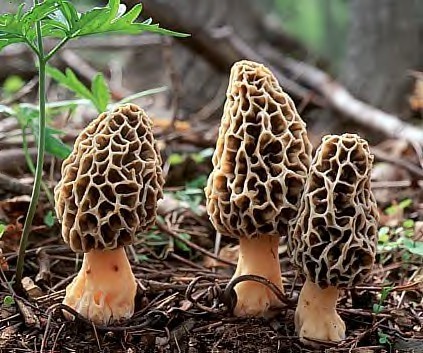

Usually, by mid-August, I have found several flowerings of the golden, delicious chanterelle, in spots known to produce faithfully year in and out.But this year,only a pittance, and those, old and rubbery (although still tasty).
I had put off writing a new posting until a good cache had been found--something to write about!!
But, sadly, this posting is about the absence of mushrooms.
I suppose it might have been the searing heat of July that closed down the summer's
fungal florescence, but who is to know? It's always been a mysterious science, understanding what causes the underground mycellium to shoot up their fruit.But I am an optimist and can see myself in another week coming home with a basketful of the critters.We have had some cool, rainy days.
Chanterelles are-- morels aside-- the best, the most pronounced in flavor. They have an aroma unique, rather reminiscent of apricots. You can find them in some gourmet stores but they are usually old and dried out, hardly worth their exorbitant price.
They are relatively easy to identify and often can be found in abundance.
DO NOT INGEST ANY MUSHROOM OF WHICH YOU HAVE THE SLIGHTEST DOUBT!
Chanterelles are found all over but seem to thrive in more northerly climes (but in California they love the coastal oak habitat). In the birch and spruce forest of Scandinavia and the Baltic states, they can be found in profusion, and there is a certain mystique around them in those countries--folk tales abound about mushrooms throughout the northern European lands.
One of the better known composers of Estonia, Lepo Sumera, who sadly died in 2000 at only fifty, admits of a spiritual connection to the native fungi of his home land (see his picure above) and has written a MUSHROOM CANTATA!! The text of this remarkable work consists of the Latin names of his favorite mushrooms .
Sumera wrote: "I came into a closer contact with mushrooms and their inner life in 1977" Think about that! The inner life of mushrooms. You might wonder if he was influenced by Cage, but I doubt it, as in the seventies Estonia was part of the Soviet Union where artistic currents from the West were severely surpressed. The style of his choral writing is often quite innovative, although at times it sounds a little hokey, too reminiscent of early Stravinsky and even Karl Orff! But for the most part the choral music on this CD, sung by the estimable Estonian Philharmonic Chamber Choir unbder Tonu Kaljuste, is compelling and beautifully dark.
(I just realized I made a bad pun above!)
Another choral work of his on the same BIS CD that I also find compelling is,in English, THOUGH YOUR HOMELAND MAY BE IN DARK FOR LONG.
If Lepo were alive today, he'd most likely be spending some time out in the late, darkening summer forests of Estonia, hunting for "Seene." I'll be thinking of him as I contemplate "the inner life of mushrooms" on my next foray (soon!)







